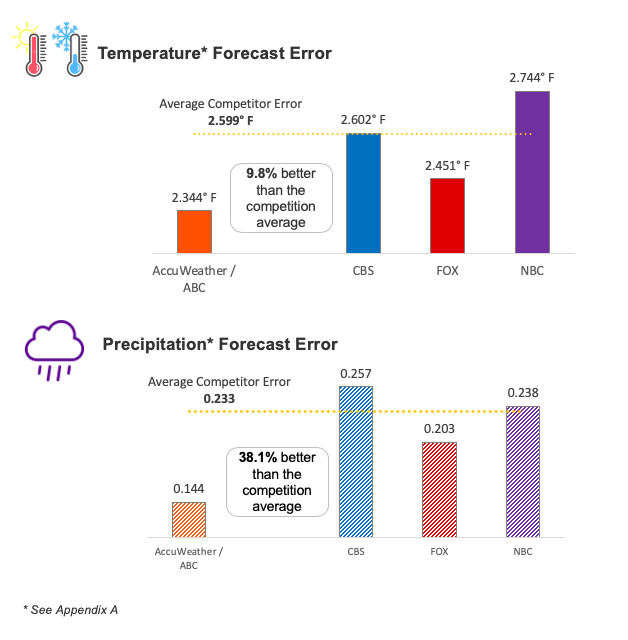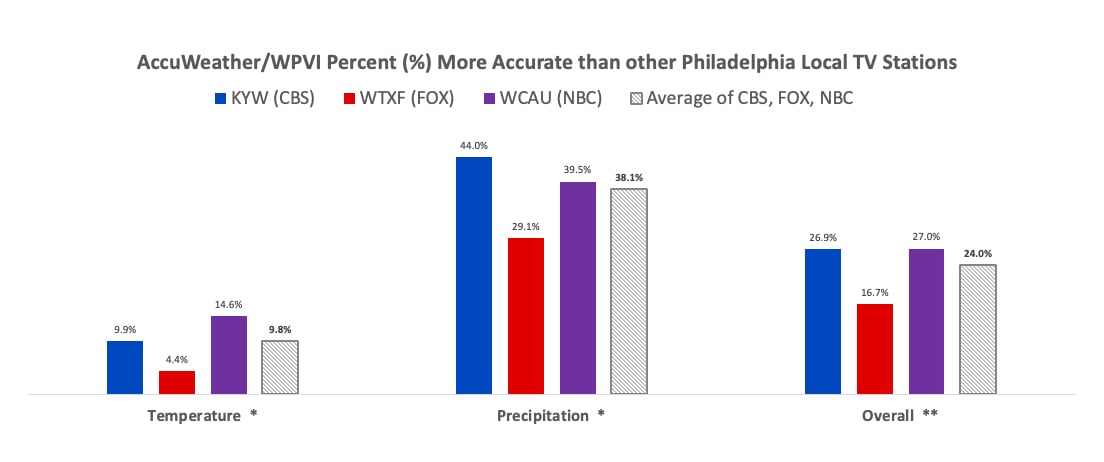
Kantar conducted a study to evaluate the accuracy of forecasts across different tv stations for AccuWeather
AccuWeather WPVI Forecast Proven Most Accurate and Most Detailed
The recent study by Kantar gathered, analyzed and compared the on-air televised weather forecast presentations of WCAU-TV, KYW-TV and WTXF-TV local stations with the AccuWeather forecast on WPVI-TV to determine which had the most accurate forecast.
Methodology
For maximum consistency, the 6 pm local time, Monday to Friday, on-air TV weathercast, which most stations provide, was viewed, and the forecast from this telecast was recorded and compared and the results verified.
Forecasts were verified by comparing them to observed data from US National Weather Service official data sources.
For a complete glossary of all terms, calculations and data sources see Appendix A and Appendix B
Findings:
The AccuWeather/WPVI-TV Weather Forecast is the Most Accurate in Philadelphia
- The AccuWeather/WPVI-TV forecasts were 24% more accurate than the competitor average
- The AccuWeather/ WPVI-TV weather forecast was 9.8% better than the competitor average in forecasting temperature
- The AccuWeather/ WPVI-TV weather forecast was 38.1% better than the competitor average in forecasting precipitation


AccuWeather/WPVI-TV is Most Accurate for Temperature and Precipitation
The graph shows the overall accuracy of the AccuWeather/WPVI-TV weathercast vs. other local TV stations in the Philadelphia market. The AccuWeather/WPVI-TV forecasts were the most accurate overall by 24%. AccuWeather/WPVI-TV weather forecast was 16.7% more accurate than WTXF-TV, 26.9% more accurate than KYW-TV and 27% more accurate than WCAU-TV.
AccuWeather/ WPVI-TV Weather Forecast Ranked #1 in Philadelphia for Providing Impact-Driven, Useful Details
In Philadelphia, the AccuWeather/ABC station, WPVI-TV, provided the most impact-driven weathercasts with much more useful and localized forecast detail and important information than the other Philadelphia stations.
The AccuWeather/WPVI-TV weathercast was ranked #1 in providing the most detail:
- Changeover in type of precipitation: 50% more often
- Special details: 33% more often
- Hyperlocal weather variations: 11% more often
- Weather comparison across days: 9% more often
- Variation in probability of precipitation across the area: 6% more often
About Kantar
Kantar is the world’s leading data, evidence-based, insights and consulting company, serving more than half of the Fortune 500 companies worldwide.
We have a complete, unique and rounded understanding of how people think, feel and act; globally and locally in over 90 markets. By combining the deep expertise of our people, our data resources and benchmarks, our innovative analytics and technology, we help our clients understand people and inspire growth.
Appendix A — Definitions
- Brier Score – A standard measure of the accuracy of probability of precipitation forecasts. Uses the forecasted probability (e.g. 60% = 0.6) and the observed precipitation (e.g. 0 for no precipitation OR 1 for precipitation). The resulting equation is (F – O)2 which is then summed for the entire dataset. Numbers close to 0 signify a more accurate forecast.
- Average Error – The average of the given accuracy metric. For example, if showing the average competitor error in a temperature chart, this is the average of errors from each competitor over the course of the study. If WCAU-TV had a temperature error of 4F, KYW-TV an error of 2F, and WTXF-TV and error of 3F, the average error would be 3F.
- Precipitation – The Brier scores (see above) were aggregated for all forecasts during the study for forecast Days 1 to 5 (Monday through Friday). Therefore, the precipitation accuracy results in this study show the accuracy of probability of precipitation forecasts. In a case where specific probability was not mentioned, the forecast text predicting the precipitation was used to provide a percentage value. A mention of words that indicated uncertainty like “showers possible,” “might rain,” “rain possible” was given a value of 50%. A certain mention of precipitation was given a value of 100%.
- Temperature – For temperature, average temperature was calculated using high and low, adding them together and dividing by 2. This was done for both forecast temperature (Days 1 to 5) and observed temperatures. The absolute error was then averaged across all forecasts.